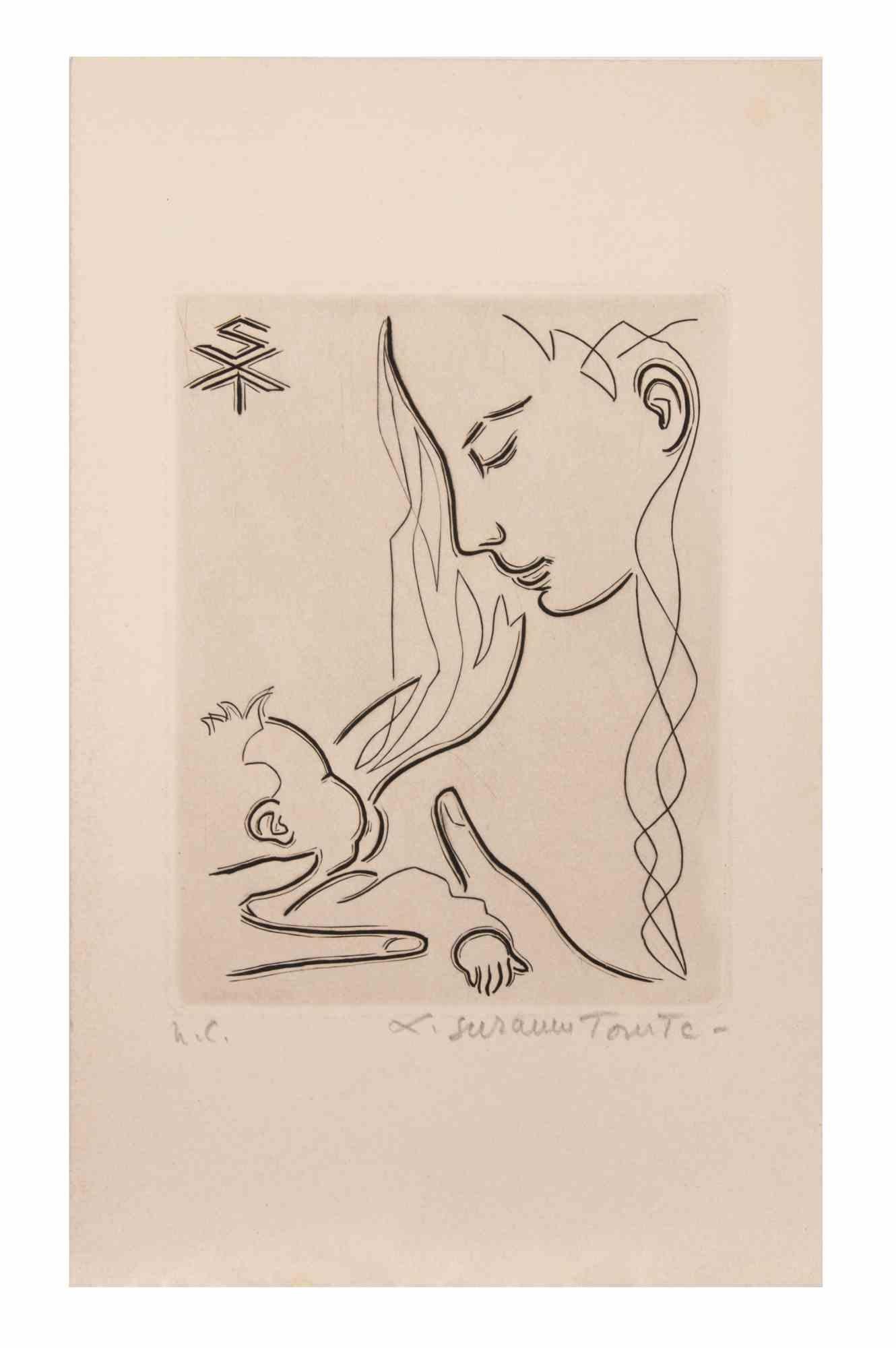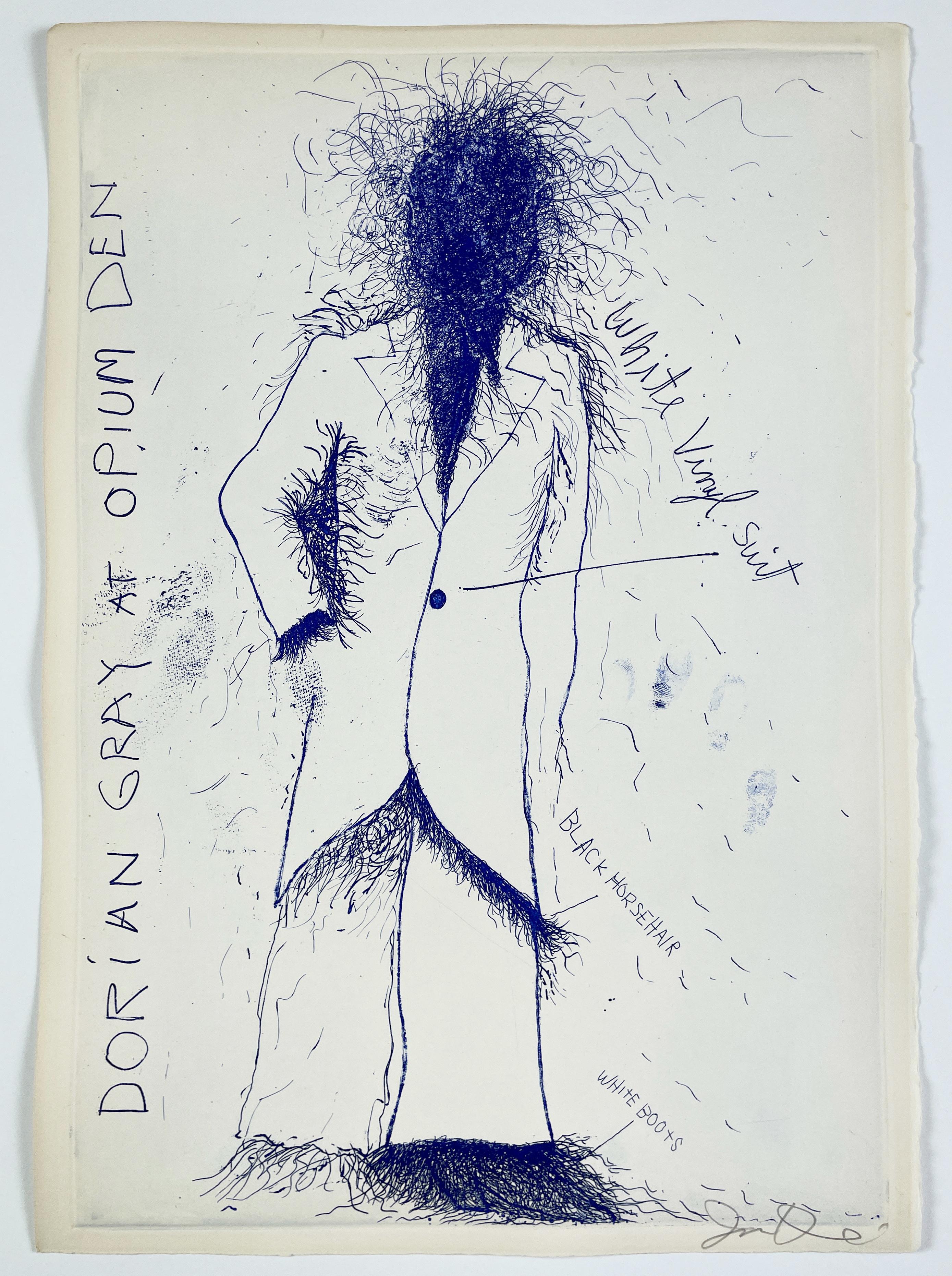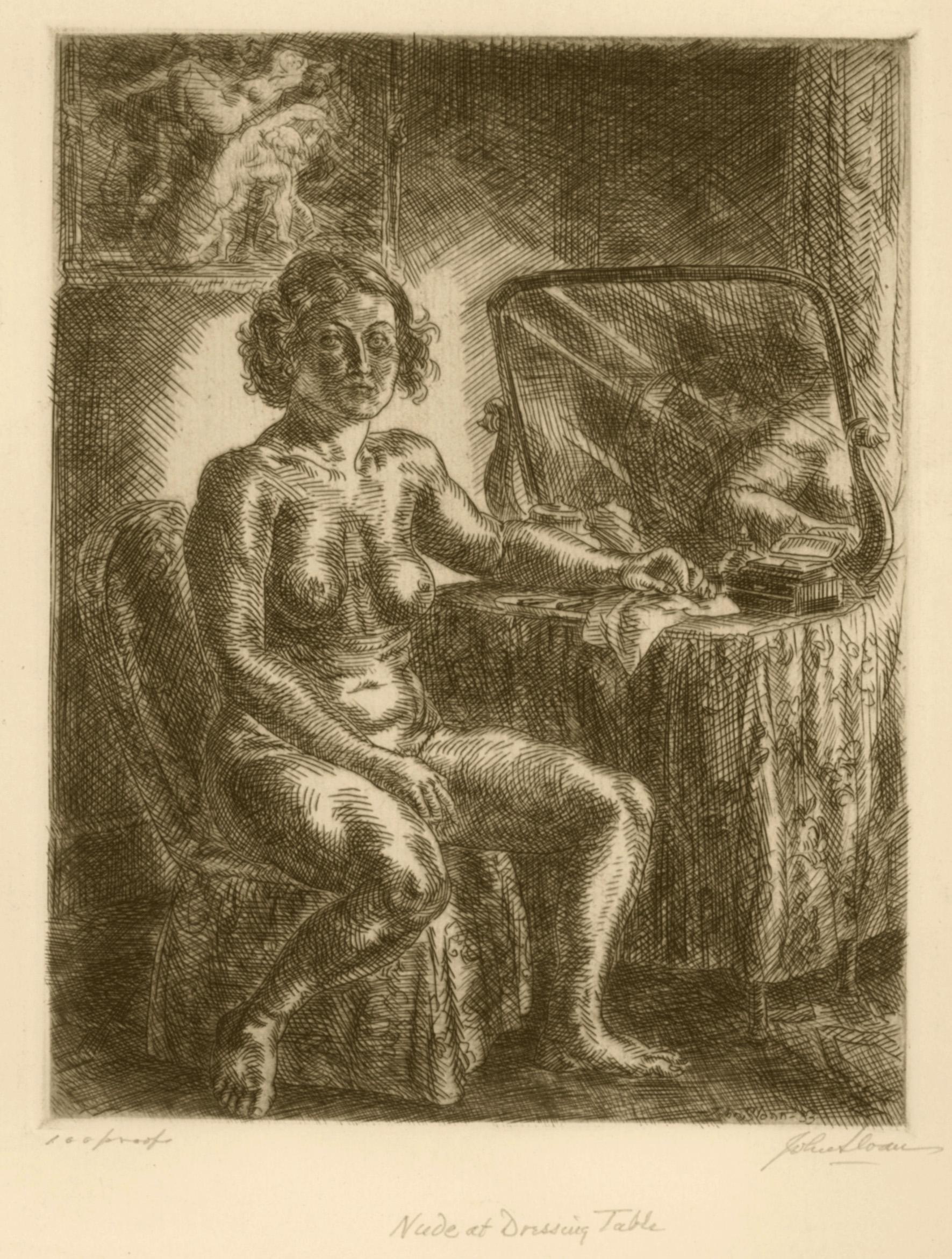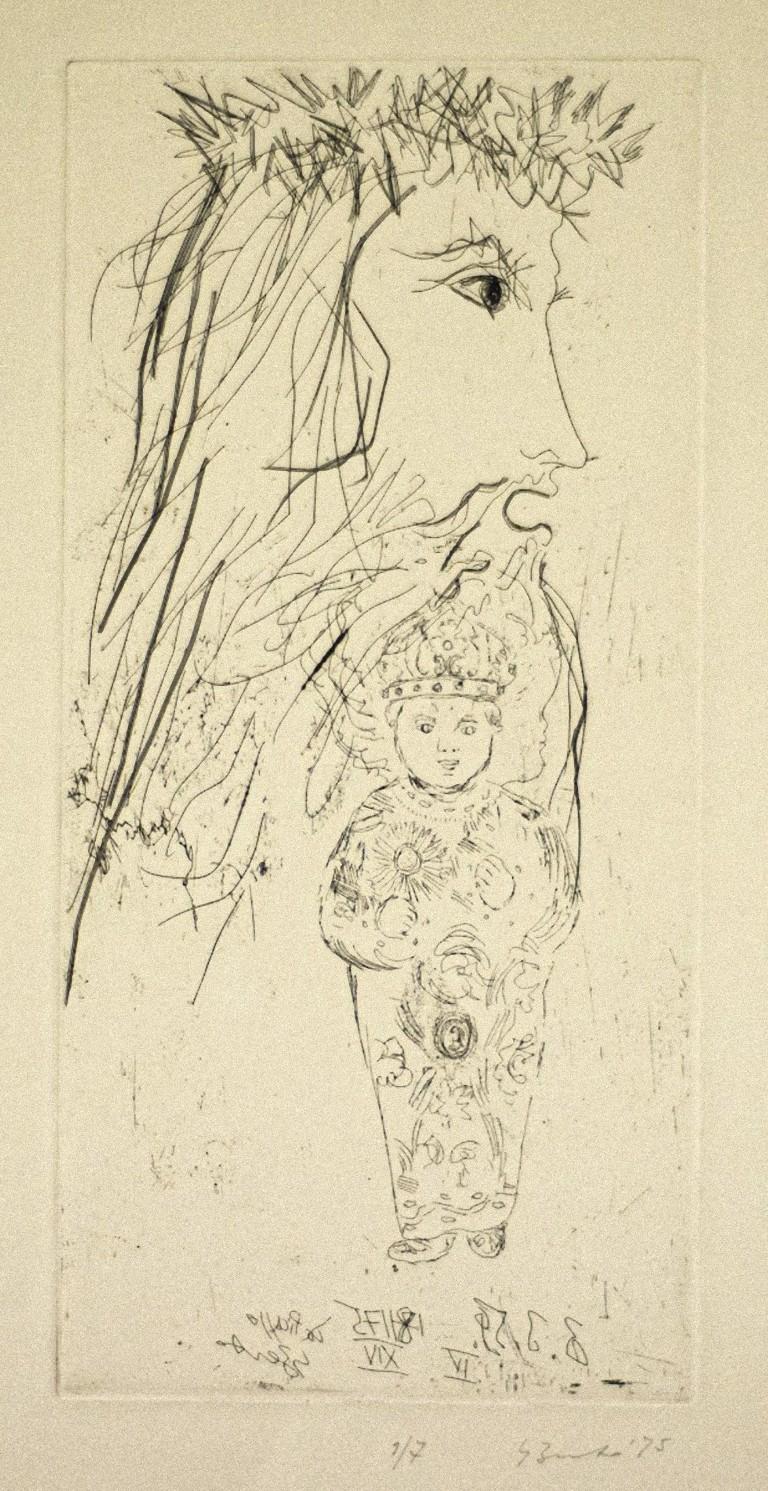Marie Laurencin"Jeune Fille, " Original Sepia Portrait Etching signed by Marie Laurencinc. 1930s
c. 1930s
About the Item
- Creator:Marie Laurencin (1883-1956, French)
- Creation Year:c. 1930s
- Dimensions:Height: 20.875 in (53.03 cm)Width: 19.375 in (49.22 cm)
- Medium:
- Movement & Style:
- Period:
- Condition:
- Gallery Location:Milwaukee, WI
- Reference Number:
Marie Laurencin
Artist Marie Laurencin is best known for her enchanting portraits of women and young girls. The Parisian artist was linked to the avant-garde Cubist movement, but she endeavored to disassociate herself from the style as she instead drew on the Impressionist style of Pierre-Auguste Renoir in her paintings and prints, and created poetic, overtly sensual images of women in Fauvism’s subdued pastels at a time when the leagues of male artists around her became famous for making still lifes.
Just as Renoir and other painters began their careers painting pottery in Limoges, Laurencin trained in porcelain painting in the southwestern suburbs of Paris before she studied oil painting at Académie Humbert alongside influential Cubist painter Georges Braque and French designer and painter Francis Picabia. Her circle consisted of widely known and reputable artists including Braque and Pablo Picasso, with whom she exhibited. Her romantic partners were both male and female over the years, and she repeatedly refused marriage proposals from the most famous art dealer at the time, Sir Joseph Duveen, Baronet. Laurencin had a romantic relationship with French poet Guillaume Apollinaire that lasted six years.
Laurencin produced most of her best known work throughout the 1920s. During this era, she worked with art dealer Paul Rosenberg although she frequently ignored his business advice. Known to only paint children she liked, Laurencin also charged men twice that of women, as well as brunettes more than blondes, and offered discounts for works she enjoyed doing and steeper prices for those she cared less for.
Laurencin’s work increasingly attracted attention over time — she had more than ten solo exhibitions in 1939 alone and was commissioned for portraits by the likes of Jean Cocteau and Coco Chanel. (Revered fashion designer Karl Lagerfeld — who consistently displayed a knack for synthesizing old and new, high and low — drew on the work of Laurencin in his Spring/Summer 2011 collection for Chanel.)
Laurencin’s six illustrations of "Alice" in a 1930 edition of Lewis Carroll's Alice in Wonderland comprise a small sample of the art she made that is held in the public collection of the Museum of Modern Art. Her works are also held in the collections of the Metropolitan Museum of Art, the Musée d’Orsay and the National Museum of Women in the Arts. In 1983, a museum opened in her honor — the Musée Marie Laurencin in Nagano, Japan. At the time, it was the only museum in the world to focus solely on a female painter.
Find original Marie Laurencin paintings and prints on 1stDibs.
- ShippingRetrieving quote...Ships From: Milwaukee, WI
- Return PolicyA return for this item may be initiated within 14 days of delivery.
- "Mes Petites Amies, Les Deux Sœurs" signed by Jacques VillonBy Jacques VillonLocated in Milwaukee, WIThis is an original drypoint and aquatint artwork by Jacques Villon. The artist signed in pencil on the lower right. As well as signed in plate at the top right of the image. This is a wonderful artwork of different intaglio processes being brought together in a beautiful almost seamless harmony. The thin pencil like markings and hair detailing are made using the Drypoint printmaking method. Whilst the color details around the girls are made using the Aquatint etching method. Jacques Villon shows his skills as a printmaker with the way these pieces line up perfectly and with how clean the rest of the plate is around the girls. Catalogue Raisonne E101, pg. 66-67 (Ginestet & Pouillon. It depicts two young girls. 15" x 11 1/2" art 25 1/8" x 20" frame French painter, printmaker and illustrator. The oldest of three brothers who became major 20th-century artists, including Raymond Duchamp-Villon and Marcel Duchamp, he learnt engraving at the age of 16 from his maternal grandfather, Emile-Frédéric Nicolle (1830-94), a ship-broker who was also a much appreciated amateur artist. In January 1894, having completed his studies at the Lycée Corneille in Rouen, he was sent to study at the Faculty of Law of the University of Paris, but within a year he was devoting most of his time to art, already contributing lithographs to Parisian illustrated newspapers such as Assiette au beurre. At this time he chose his pseudonym: Jack (subsequently Jacques) in homage to Alphonse Daudet’s novel Jack (1876) and Villon in appreciation of the 15th-century French poet François Villon...Category
Early 1900s Modern Figurative Prints
MaterialsDrypoint, Aquatint, Etching, Intaglio
- 20th century aquatint etching figurative portrait ink unfinished female subjectBy Moishe SmithLocated in Milwaukee, WI"Maria (Artist's Wife)" is an original etching by Moishe Smith, signed in the bottom right corner and numbered in the bottom left. The piece depicts a seated woman from the waist up,...Category
1960s Post-Modern Figurative Prints
MaterialsPaper, Etching, Aquatint
- "Young Girl With Hat, " Victorian Portrait Etching signed Frederick M. SpiegleBy Frederick M. SpiegleLocated in Milwaukee, WI"Young Girl With Hat" is a classical Victorian portrait etching. It is signed in graphite in the lower right by the artist, F.M. Spiegle. It depicts a Victorian girl with curly hair ...Category
Late 19th Century American Realist Portrait Prints
MaterialsInk, Paper, Etching
- 'Self Portrait 1974' original etching signed by Sandra SweeneyBy Sandra SweeneyLocated in Milwaukee, WIFollowing in line with artists before her, like Rembrandt and van Gogh, Sandra Sweeny here presents a self portrait. The image is both direct and subtle not only in its handling of m...Category
1970s Contemporary Portrait Prints
MaterialsEtching, Paper
- "La Mere de Whistler, " an Etching and Drypoint signed by Auguste BrouetBy Auguste BrouetLocated in Milwaukee, WI"La Mere de Whistler" is an original etching and drypoint signed by the French artist Auguste Brouet in the lower right. It depicts famous artist James Abbott McNeill Whistler's moth...Category
Early 20th Century Portrait Prints
MaterialsEtching, Drypoint
- 'Peter Breughel' Original Etching, Signed in PencilBy Leonard BaskinLocated in Milwaukee, WIThe present artwork is an original etching by American artist Leonard Baskin. Here, he presents a portrait of the Flemish Renaissance artist Peter Breughel the Elder in profile, executed after the engraving by Johannes Wierix published in 1572 by Volcxken Diericx and Hieronymus Cock. In the portrait, Baskin displays a love of line and texture, using the etching technique to exaggerate and draw attention to the wrinkles of the face, while leaving the hair and clothing like a study or sketch. Like in the work of contemporary artist Claude Weisbuch, the result for Baskin is an image that recalls the old masters and displays the mastery of contemporary printmakers, but that also places mid-century formal concerns at the forefront of portraiture and figuration. etching in black in on Rives paper 17.5 x 17.5 inches, plate 29.75 x 22 inches, sheet 33.5 x 25.88 inches, frame Entitled "Breughel" in pencil, lower left Edition 9/50 in pencil, lower center Signed in pencil, lower right "PB" in the plate, upper left "PB" in the plate, upper right (faint) Label for Irving Galleries, Milwaukee on reverse Label for David Barnett Gallery on reverse Framed behind glass in a distressed cassetta-style moulding Artwork in overall good condition; general toning to the paper; some scattered foxing; frame in good condition with some losses to finished surface revealing white ground Born in 1922 in New Brunswick, New Jersey, Baskin was reared in Brooklyn, New York. The son of a Rabbi, Baskin was educated at a yeshiva (Jewish religious college), which had a profound effect on his aesthetic. Committed to art at an early age, Baskin had his first exhibition. of sculpture, at the Glickman Studio Gallery, New York, at the age of seventeen. He studied at Yale University from 1941 to 1943 and received his B.A. at the New School for Social Research in 1949. Baskin spent 1950 and 1951 abroad, studying in Paris and Florence. In 1953 he began teaching printmaking and sculpture at Smith College in Northampton, Massachusetts, where he remained until 1974. It was while he was at Smith College that he founded Gehenna Press, a small private press specializing in fine book production. He moved to England in 1974 and stayed till 1983 when he returned to America.. These nine years were enormously productive and besides sculptures he created a fine selection of prints and paintings. Baskin became intrigued by Greek history, philosophy and mythology at an early age and this study inspired many of his sculptures and paintings. Other influences were early 20th century sculptors, notably Ernst Barlach Leonard Baskin was one of the universal artists of the 20th century. He was a sculptor of renown. He was a writer and illustrator of books ranging from the bible to children's' stories and natural history. He was a talented water-colourist and a superb, prolific print-maker. His prints ranged from woodcuts through lithography and etching; his subjects covered portraits...Category
1960s Old Masters Portrait Prints
MaterialsPaper, Etching
- Portrait - Etching by Claudin Felix - 19th centuryLocated in Roma, ITPortrait is an original artwork realized by Claudin Felix (1875-1956). Original etching. Image Dimensions: 19.5 x 16 cm. Good conditions except for some foldings. The artwork rep...Category
19th Century Modern Figurative Prints
MaterialsEtching
- Woman in the Mirror - Etching by Enrico Palù - 1973Located in Roma, ITWoman in the Mirror is an Etching realized by Enrico Palù in 1973. Good condition included a cream colored cardboard passpartout (45x31.5 cm). Hand signed and dated by the artist o...Category
1970s Modern Figurative Prints
MaterialsEtching
- A Feeding Woman - Etching by Suzanne Tourte - 1950sLocated in Roma, ITA feeding woman is an artwork realized by Suzanne Tourte in 1950s. Etching, 22 x 13 cm. Artist's proof. Hand signed on the right left. Good conditi...Category
1950s Modern Figurative Prints
MaterialsEtching
- Dorian Gray at Opium Den from "The Picture of Dorian Gray" surreal portraitBy Jim DineLocated in New York, NYThis surreal etching portrait of Dorian Gray by Jim Dine in blue ink features the literary protagonist dressed in a white suit. His face is obscured by a mass of hair, tangles of which seem to grow from the sleeves, pant legs, and from beneath the jacket. Dine's notes are written on the image: at his feet reading "WHITE BOOTS" and "White Vinyl Suit" alongside the jacket. On the left edge of the image handwritten text reads "DORIAN GRAY AT OPIUM DEN". In Oscar Wilde's novel Dorian Gray keeps opium in an ornate box in his home, and frequents sites of consumption on the East side of London: “There were opium dens where one could buy oblivion, dens of horror where the memory of old sins could be destroyed by the madness of sins that were new”. An opium den is where Sybil's brother James discovers Dorian. The brother attempts to capture the man he believes is responsible for the death of his sister. Dorian flees to his home, ultimately slashing the portrait that has kept him young for so long. Etching by Jim Dine from one of his most important artist’s books – completely designed and illustrated by Dine. Study for the Rings on Dorian Gray’s Hand from “The Picture of Dorian Gray...Category
1960s Modern Figurative Prints
MaterialsEtching
- Nude at Dressing TableBy John SloanLocated in Middletown, NYSloan was so fond of this composition that he made a painting after the etching ten years after its completion, in 1943. Completed in Santa Fe, the painting is now housed in the perm...Category
1930s American Modern Nude Prints
MaterialsEtching
- King David - Etching on Paper by Gian Paolo Berto - 1975Located in Roma, ITKing David is an original etching on paper realized by Gian Paolo Berto, in 1975. Good conditions. Hand-signed and numbered, rare edition: 1/7. Sheet dimension: 70 x 50 The artwo...Category
1970s Modern Figurative Prints
MaterialsEtching






